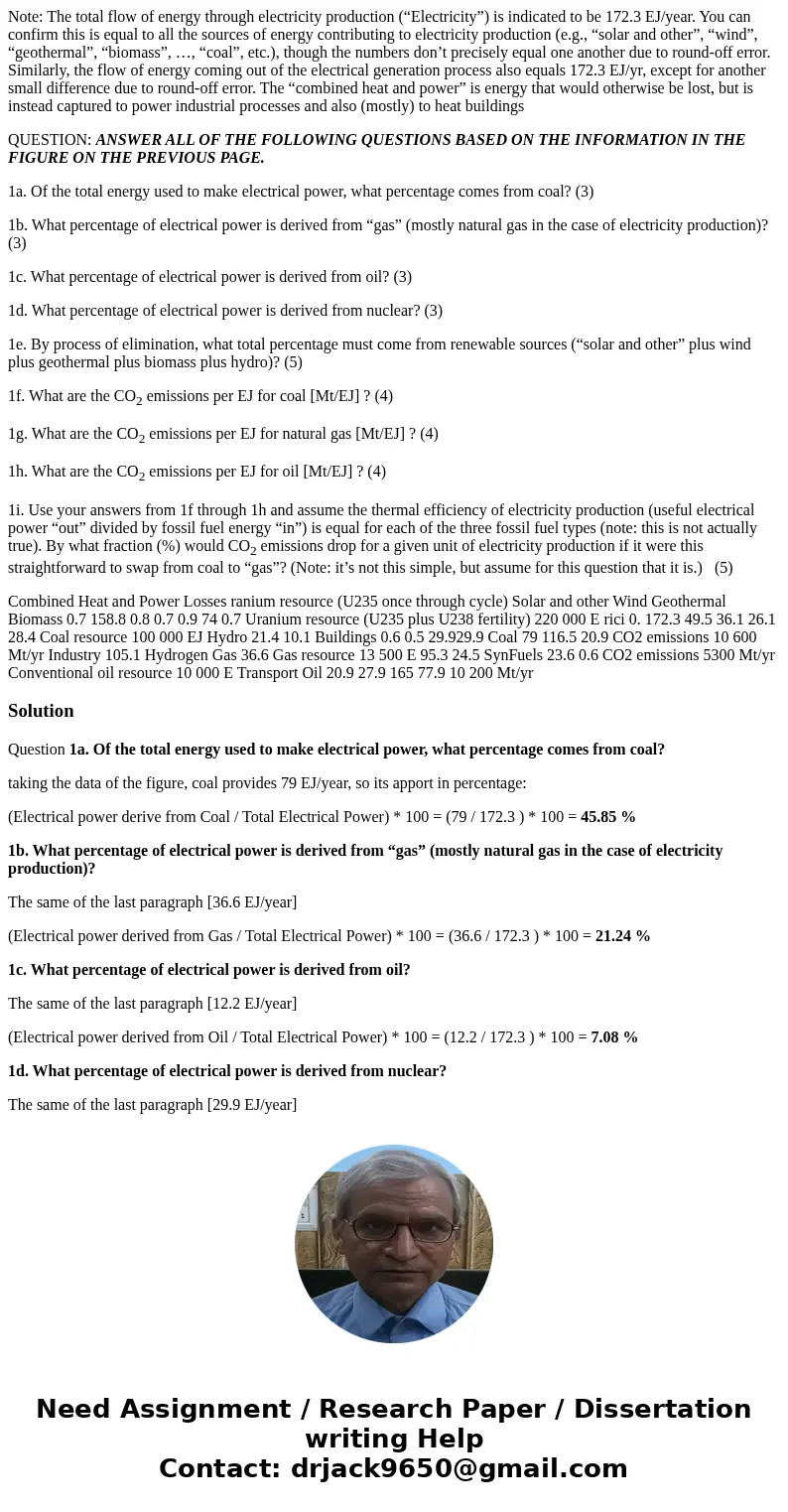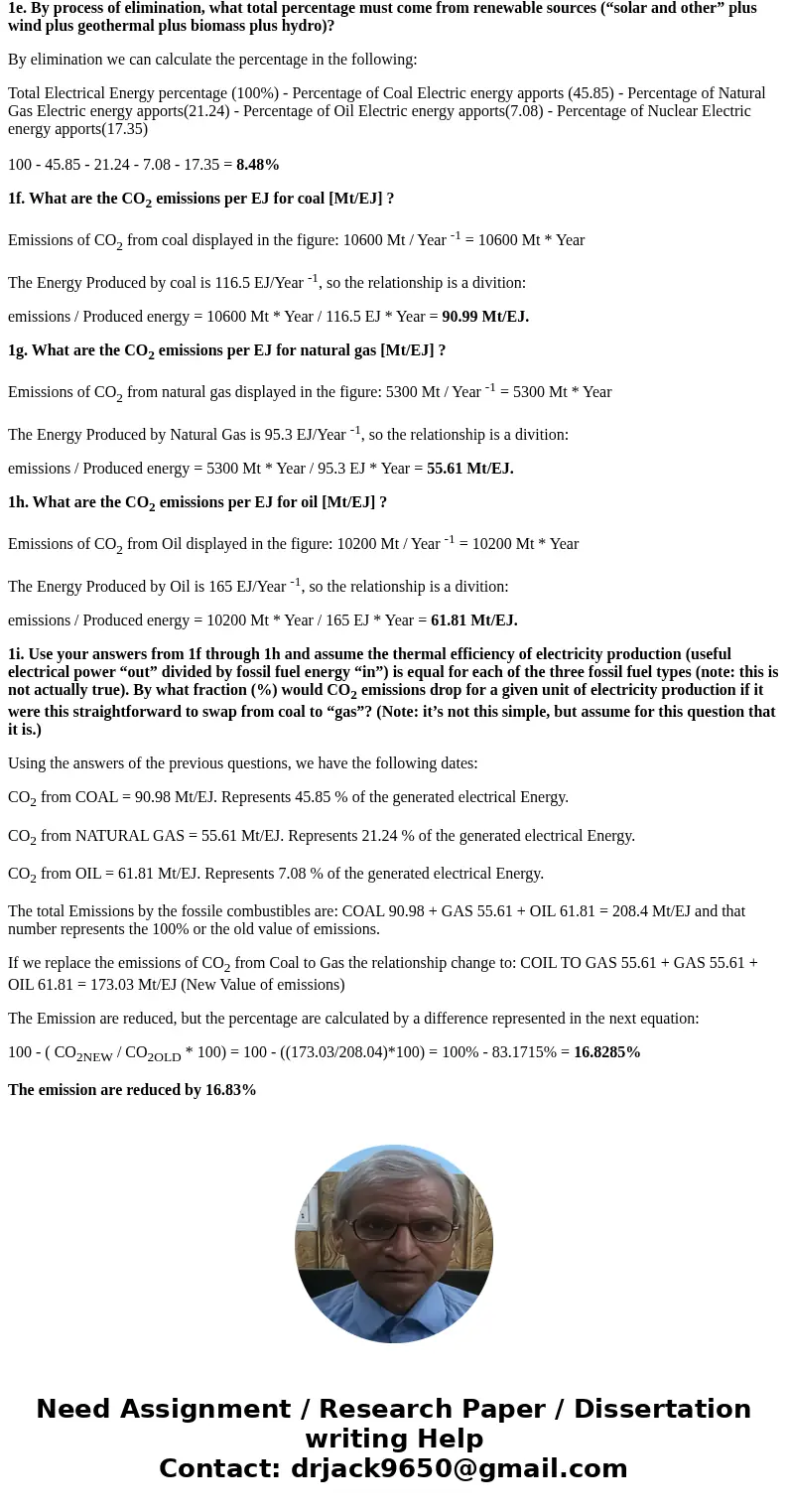Note The total flow of energy through electricity production
Note: The total flow of energy through electricity production (“Electricity”) is indicated to be 172.3 EJ/year. You can confirm this is equal to all the sources of energy contributing to electricity production (e.g., “solar and other”, “wind”, “geothermal”, “biomass”, …, “coal”, etc.), though the numbers don’t precisely equal one another due to round-off error. Similarly, the flow of energy coming out of the electrical generation process also equals 172.3 EJ/yr, except for another small difference due to round-off error. The “combined heat and power” is energy that would otherwise be lost, but is instead captured to power industrial processes and also (mostly) to heat buildings
QUESTION: ANSWER ALL OF THE FOLLOWING QUESTIONS BASED ON THE INFORMATION IN THE FIGURE ON THE PREVIOUS PAGE.
1a. Of the total energy used to make electrical power, what percentage comes from coal? (3)
1b. What percentage of electrical power is derived from “gas” (mostly natural gas in the case of electricity production)? (3)
1c. What percentage of electrical power is derived from oil? (3)
1d. What percentage of electrical power is derived from nuclear? (3)
1e. By process of elimination, what total percentage must come from renewable sources (“solar and other” plus wind plus geothermal plus biomass plus hydro)? (5)
1f. What are the CO2 emissions per EJ for coal [Mt/EJ] ? (4)
1g. What are the CO2 emissions per EJ for natural gas [Mt/EJ] ? (4)
1h. What are the CO2 emissions per EJ for oil [Mt/EJ] ? (4)
1i. Use your answers from 1f through 1h and assume the thermal efficiency of electricity production (useful electrical power “out” divided by fossil fuel energy “in”) is equal for each of the three fossil fuel types (note: this is not actually true). By what fraction (%) would CO2 emissions drop for a given unit of electricity production if it were this straightforward to swap from coal to “gas”? (Note: it’s not this simple, but assume for this question that it is.) (5)
Combined Heat and Power Losses ranium resource (U235 once through cycle) Solar and other Wind Geothermal Biomass 0.7 158.8 0.8 0.7 0.9 74 0.7 Uranium resource (U235 plus U238 fertility) 220 000 E rici 0. 172.3 49.5 36.1 26.1 28.4 Coal resource 100 000 EJ Hydro 21.4 10.1 Buildings 0.6 0.5 29.929.9 Coal 79 116.5 20.9 CO2 emissions 10 600 Mt/yr Industry 105.1 Hydrogen Gas 36.6 Gas resource 13 500 E 95.3 24.5 SynFuels 23.6 0.6 CO2 emissions 5300 Mt/yr Conventional oil resource 10 000 E Transport Oil 20.9 27.9 165 77.9 10 200 Mt/yrSolution
Question 1a. Of the total energy used to make electrical power, what percentage comes from coal?
taking the data of the figure, coal provides 79 EJ/year, so its apport in percentage:
(Electrical power derive from Coal / Total Electrical Power) * 100 = (79 / 172.3 ) * 100 = 45.85 %
1b. What percentage of electrical power is derived from “gas” (mostly natural gas in the case of electricity production)?
The same of the last paragraph [36.6 EJ/year]
(Electrical power derived from Gas / Total Electrical Power) * 100 = (36.6 / 172.3 ) * 100 = 21.24 %
1c. What percentage of electrical power is derived from oil?
The same of the last paragraph [12.2 EJ/year]
(Electrical power derived from Oil / Total Electrical Power) * 100 = (12.2 / 172.3 ) * 100 = 7.08 %
1d. What percentage of electrical power is derived from nuclear?
The same of the last paragraph [29.9 EJ/year]
(Electrical power derived from Nuclear Energy / Total Electrical Power) * 100 = (29.9 / 172.3 ) * 100 = 17.35 %
1e. By process of elimination, what total percentage must come from renewable sources (“solar and other” plus wind plus geothermal plus biomass plus hydro)?
By elimination we can calculate the percentage in the following:
Total Electrical Energy percentage (100%) - Percentage of Coal Electric energy apports (45.85) - Percentage of Natural Gas Electric energy apports(21.24) - Percentage of Oil Electric energy apports(7.08) - Percentage of Nuclear Electric energy apports(17.35)
100 - 45.85 - 21.24 - 7.08 - 17.35 = 8.48%
1f. What are the CO2 emissions per EJ for coal [Mt/EJ] ?
Emissions of CO2 from coal displayed in the figure: 10600 Mt / Year -1 = 10600 Mt * Year
The Energy Produced by coal is 116.5 EJ/Year -1, so the relationship is a divition:
emissions / Produced energy = 10600 Mt * Year / 116.5 EJ * Year = 90.99 Mt/EJ.
1g. What are the CO2 emissions per EJ for natural gas [Mt/EJ] ?
Emissions of CO2 from natural gas displayed in the figure: 5300 Mt / Year -1 = 5300 Mt * Year
The Energy Produced by Natural Gas is 95.3 EJ/Year -1, so the relationship is a divition:
emissions / Produced energy = 5300 Mt * Year / 95.3 EJ * Year = 55.61 Mt/EJ.
1h. What are the CO2 emissions per EJ for oil [Mt/EJ] ?
Emissions of CO2 from Oil displayed in the figure: 10200 Mt / Year -1 = 10200 Mt * Year
The Energy Produced by Oil is 165 EJ/Year -1, so the relationship is a divition:
emissions / Produced energy = 10200 Mt * Year / 165 EJ * Year = 61.81 Mt/EJ.
1i. Use your answers from 1f through 1h and assume the thermal efficiency of electricity production (useful electrical power “out” divided by fossil fuel energy “in”) is equal for each of the three fossil fuel types (note: this is not actually true). By what fraction (%) would CO2 emissions drop for a given unit of electricity production if it were this straightforward to swap from coal to “gas”? (Note: it’s not this simple, but assume for this question that it is.)
Using the answers of the previous questions, we have the following dates:
CO2 from COAL = 90.98 Mt/EJ. Represents 45.85 % of the generated electrical Energy.
CO2 from NATURAL GAS = 55.61 Mt/EJ. Represents 21.24 % of the generated electrical Energy.
CO2 from OIL = 61.81 Mt/EJ. Represents 7.08 % of the generated electrical Energy.
The total Emissions by the fossile combustibles are: COAL 90.98 + GAS 55.61 + OIL 61.81 = 208.4 Mt/EJ and that number represents the 100% or the old value of emissions.
If we replace the emissions of CO2 from Coal to Gas the relationship change to: COIL TO GAS 55.61 + GAS 55.61 + OIL 61.81 = 173.03 Mt/EJ (New Value of emissions)
The Emission are reduced, but the percentage are calculated by a difference represented in the next equation:
100 - ( CO2NEW / CO2OLD * 100) = 100 - ((173.03/208.04)*100) = 100% - 83.1715% = 16.8285%
The emission are reduced by 16.83%



 Homework Sourse
Homework Sourse